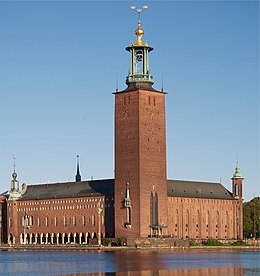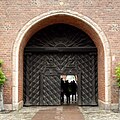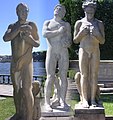Stockholm's stadshus
Stockholms stadshus , the town hall of the Swedish capital Stockholm , houses the seat of the city government and the city parliament. It is located on the southeastern tip of the island of Kungsholmen on Riddarfjärden in Lake Mälaren . The Eldkvarn steam-powered mill was located in the same place until it was destroyed by fire on October 31, 1878 .
Emergence
The town hall was built between 1911 and 1923 according to plans by the architect Ragnar Östberg in the style of Swedish national romanticism and inaugurated on June 23, 1923. The construction was carried out by the Kreuger & Toll company of the businessman Ivar Kreuger, who later became famous as the “match king” . The east and south wings overlook the lake and are combined by a 106-meter-high corner tower, which is crowned by the Tre Kronor coat of arms .
Originally it was planned to build an office building (rådhus) on this property , which would house the magistrate and the city court. The design by Ragnar Östberg emerged victorious from the architecture competition organized in 1903/04. But shortly afterwards the city government decided to erect a representative building for the city government and the city parliament on this property. Ragnar Östberg was asked to revise his entry in this sense, while Carl Westman , who came second in the competition, was commissioned to build the office building, today's Stockholms rådhus , on a plot of land nearby. In his new design, Östberg stuck to the main features of his first design, namely the symbolic relationship to the water and the dominant corner tower. At the same time he took up Mediterranean elements, especially from Venice , which find their expression in the Bürgerhof ( Borgargården ) and the Blue Hall ( Blå Hallen ), which, by the way, is not blue.
layout
Numerous artists were hired to design and furnish the town hall. On the design worked u. a. the painters Axel Törneman , Einar Forseth and Prinz Eugen , the furniture designers Ernst Spolén, Melchior Wernstedt and Carl Malmsten and the textile artist Maja Sjöström . The Stadshusparken is decorated with statues by the sculptor Carl Eldh , u. a. the trilogy from 1923, "Author" Författaren ( August Strindberg ), "Poet" Skalden ( Gustav Fröding ) and "Painter" Målaren ( Ernst Josephson ), which initially provoked strong protests because of their nudity.
Particularly noteworthy are the representation rooms of the town hall, such as the golden hall ( Gyllene salen ) with the gold mosaics made by Puhl & Wagner based on the designs of Einar Forseth, the advisory hall ( Rådsalen ) in which the Stockholm city government meets every third week, the gallery of the Prince ( Prinsens galleri ) and the Blue Hall ( Blå hallen ), where the annual banquet for the Nobel Prizes is held.
One of the wooden town hall gates, the Huvudportal, is made of black oak. The wood for this comes from the sailing warship Riksäpplet (Reichsapfel), which sank in 1676 near Dalarö , which served as a flagship for the former Reichsadmiral from 1675 to 1676 and was blown up at the wreck site at a depth of 15 m in 1921 so that the wood could be reused.
Townhouse tower
The tower is inspired by the tower of the old royal palace Drei Kronen , which was destroyed by fire in 1697. The tower is 106 m high and weighs around 24,000 t due to the 2.5 million bricks used. There are 365 steps to the top of the tower with a view of the city. The ascent takes place in narrow, seemingly endless corridors directly behind the outer walls of the tower. On the way up, you first pass the spectator gallery ( åhörareläktaren ) and a large iron door that leads to the maiden tower , named after the princess who waits behind barred windows for the rescue of Saint George; it is placed higher up in the tower.
In the tower museum models of the busts and statues of the town hall are exhibited, as well as samples for the mosaics of the Golden Hall. The outstanding exhibit is the statue of Saint Erik, the patron saint of Stockholm, designed by the Sandberg brothers for the open spire. With its 7.6 m height, the statue could not be transported there by conventional means - therefore skylights were created that go through all levels of the tower. A crane in the top of the tower was supposed to lift the statue up. However, the architect Ragnar Östberg changed his plans and instead designed the spire as an open viewing platform.
Further up in the Circular Passage there are four plaster models of the statues that were intended for the tower terrace above : Maria Magdalena, Saint Clare, Saint Erik and Saint Nicholas.
The tower passage leads to the roof truss, where the wooden structure of the bell tower, the wooden tower , begins. Above are the glockenspiel gears and the mentioned crane for the statues.
About the observation deck, the copper tower , is the tower terrace to 73 m high with the four aforementioned saints. Maria Magdalena, Saint Clare and Saint Erik are turned towards their respective parishes. Saint Nicholas does not belong to a community, he is the patron saint of seafarers.
The nine tower bells are even higher up. The largest bell, a gift from Holland, weighs 3 tons and is named after Sankt Erik. The smallest is called St. George. Under the bells, an embossed copper plate with the sights serves as an orientation aid when looking out over the city.
The three crowns on the top of the tower are each 2.2 m long and point in the direction of the old Three Crowns Castle .
Exterior views
Stockholm city hall of Södermalm seen from
Inner courtyard with a view of Riddarfjärden
Interior views
The town house tower
literature
- Walther Karbe: Ragnar Östberg's town house in Stockholm . In: Decorative art, illustrated magazine for applied arts, vol .: 33 = year 28, 1924/25, pp. 161–174 ( digitized version ).
- Rikard Larsson: The Secrets of Masonry. A guide to Stockholm City Hall . In collaboration with the Department of Architectural History at the Royal School of Art KKH Stockholm. 2nd Edition. Langenskiöld, Stockholm 2017, ISBN 978-91-87007-33-0 (141 pages, first edition: 2011, second edition has the same ISBN, apparently just a different cover).
Individual evidence
- ↑ Ivar Kreuger: Genius and Rogue. handelsblatt.com
- ↑ http://articles.portal-tol.net/english-language-sv/Stockholms%20stadshus
Web links
- Official site of the City (English)
Coordinates: 59 ° 19 ′ 39 ″ N , 18 ° 3 ′ 17 ″ E


















